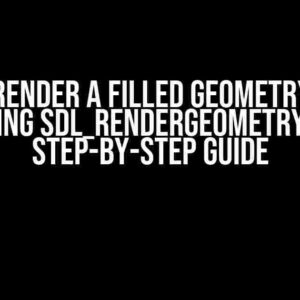Hey there, 3D enthusiasts! Are you struggling with Open3D’s basic operations on point clouds? Are error messages like “exited with code=3221225477” haunting your dreams? Fear not, dear reader, for we’ve got you covered! In this comprehensive guide, we’ll walk you through common issues, troubleshooting steps, and pro tips to get you back on track with your 3D point cloud adventures.
Understanding Point Clouds in Open3D
Before we dive into troubleshooting, let’s quickly review the basics of point clouds in Open3D. A point cloud is a set of 3D points in space, often used to represent 3D models, scenes, or objects. Open3D provides an efficient and flexible way to work with point clouds using its open3d.geometry.PointCloud class.
In Open3D, point clouds can be created from various sources, such as:
- 3D scanning devices (e.g., LiDAR, Structured Light scanners)
- Mesh files (e.g., OBJ, STL)
- Depth sensors (e.g., Kinect, RealSense)
- Generated programmatically
Basic Operations on Point Clouds
Now that we’ve covered the basics, let’s discuss some fundamental operations you might want to perform on your point clouds:
Filtering: Removing unwanted points or noise from the cloudDownsampling: Reducing the number of points to improve performance or simplify the cloudTransforming: Rotating, scaling, or translating the point cloudClustering: Grouping points into meaningful segments or clustersRegistration: Aligning multiple point clouds into a single, cohesive scene
Troubleshooting Common Issues
Now that we’ve covered the basics, let’s tackle some common issues that might be causing your Open3D point cloud operations to fail:
Error: Exited with code=3221225477
One of the most frustrating errors you might encounter is the “exited with code=3221225477” message. This error code typically indicates a memory-related issue, such as:
- Out-of-memory errors
- Inconsistent memory allocation
- Invalid memory accesses
To troubleshoot this error, try the following:
import open3d as o3d
# Ensure you have sufficient memory (RAM)
print("Available memory:", o3d.core.Device.get_memory_info().total_bytes)
# Check for memory leaks in your code
o3d.core.Device.get_memory_info().dump()
# Consider downsampling your point cloud to reduce memory usage
pcd_downsampled = pcd.voxel_down_sample(voxel_size=0.01)
Point Cloud Not Displaying Correctly
If your point cloud is not displaying as expected, check the following:
- Point cloud orientation: Ensure your point cloud is oriented correctly, especially if it’s loaded from a file
- Point cloud scale: Verify that your point cloud is scaled correctly, as Open3D uses a default unit of meters
- Visualization settings: Adjust visualization settings, such as point size, color, and rendering mode, to optimize display
import open3d as o3d
# Load point cloud from file
pcd = o3d.read_point_cloud("point_cloud.ply")
# Set point cloud orientation (optional)
pcd.transform([[1, 0, 0], [0, 1, 0], [0, 0, 1]])
# Set point cloud scale (optional)
pcd.scale(0.01, center=[0, 0, 0])
# Visualize point cloud with customized settings
o3d.visualization.draw_geometries([pcd], width=800, height=600, point_size=2, mesh_show_back_face=True)
Performance Issues
If your point cloud operations are taking an eternity to complete, consider the following optimizations:
- Downsample your point cloud: Reduce the number of points to improve performance
- Use GPU acceleration: Enable GPU acceleration if available
- Optimize algorithms: Experiment with different algorithms or implementations to find the most efficient one
import open3d as o3d # Downsample point cloud pcd_downsampled = pcd.voxel_down_sample(voxel_size=0.01) # Enable GPU acceleration (if available) o3d.core.Device.set_cuda_device(0) # Replace with your GPU device ID # Optimize algorithms (optional) pcd.estimate_normals(search_param=o3d.geometry.KDTreeSearchParamHybrid(radius=0.1, max_nn=30))
Pro Tips and Best Practices
To get the most out of Open3D and avoid common pitfalls, follow these pro tips and best practices:
| TIP | DESCRIPTION |
|---|---|
| 1. Validate point cloud data | Ensure your point cloud data is clean, consistent, and well-formatted |
| 2. Use the right data type | Choose the appropriate data type for your point cloud (e.g., float32, float64) |
| 3. Optimize point cloud structure | Organize your point cloud data in a way that minimizes memory usage and improves performance |
| 4. Monitor memory usage | Keep an eye on memory consumption to avoid out-of-memory errors |
| 5. Experiment with different algorithms | Find the most efficient algorithm for your specific use case |
Conclusion
There you have it, folks! With these troubleshooting tips, explanations, and best practices, you should be well-equipped to tackle even the most stubborn point cloud issues in Open3D. Remember to stay vigilant, experiment with different approaches, and optimize your workflows for maximum efficiency.
If you’re still encountering issues or have further questions, don’t hesitate to reach out to the Open3D community or seek help from 3D experts. Happy point cloud adventures!
Additional Resources
- Open3D Documentation: http://www.open3d.org/docs/
- Open3D GitHub: https://github.com/isl-org/Open3D
- 3D Point Cloud Processing Tutorials: https://www.google.com/search?q=3d+point+cloud+processing+tutorials
Stay tuned for more 3D-related content, tutorials, and troubleshooting guides!
Frequently Asked Question
Having trouble with Open3D and point clouds? Don’t worry, we’ve got you covered! Below are some frequently asked questions and answers to help you troubleshoot the issue.
Why do I get the error “exited with code=3221225477” when performing basic operations on point clouds in Open3D?
This error usually occurs when there’s a memory access violation or when the program tries to access memory that it’s not allowed to. It might be due to a corrupted installation of Open3D or a conflicting library. Try reinstalling Open3D or running your code in a clean environment to isolate the issue.
Can I use Open3D with Python 3.8 or later?
Unfortunately, Open3D currently only supports Python 3.6 and 3.7. If you’re using a later version, you might encounter compatibility issues. Try downgrading your Python version or using a virtual environment with a supported version.
How do I fix the “(import open3d as o3d; o3d.visualization.draw_geometries([pcd]))” issue?
This issue is usually caused by an outdated or corrupted installation of Open3D. Try reinstalling Open3D using pip (`pip install open3d`) or conda (`conda install -c conda-forge open3d`), and then restart your Python kernel. If the problem persists, try updating your Open3D version to the latest one.
Can I use Open3D with other point cloud libraries like PCL or PyntCloud?
While Open3D is a powerful point cloud processing library, it’s not directly compatible with other popular libraries like PCL or PyntCloud. However, you can use Open3D in conjunction with these libraries by converting the point cloud data between formats. For example, you can use Open3D’s `read_point_cloud` function to read a PCL point cloud file.
Why do I get a “Segmentation fault” when running Open3D code?
A “Segmentation fault” usually indicates a memory access violation, which can be caused by a variety of reasons, including a corrupted installation, conflicting libraries, or a buggy Open3D version. Try reinstalling Open3D, updating your Open3D version, or running your code in a clean environment to isolate the issue.




